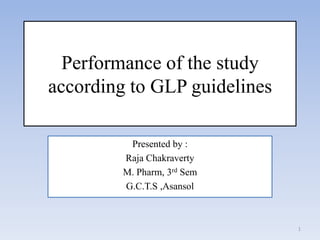
Raja glp
- 1. Performance of the study according to GLP guidelines Presented by : Raja Chakraverty M. Pharm, 3rd Sem G.C.T.S ,Asansol 1
- 2. Overview • Introduction to Good Laboratory Practices (GLP) • OECD Principles for GLP • Performance of the study • The Study Plan • Content of the Study Plan • Conduct of the study • Further Readings 2
- 3. GLP : An Introduction • Good Laboratory Practice (GLP) is concerned with the organisational process and the conditions under which laboratory studies are planned, performed, monitored, recorded, and reported. ( From OECD Guidelines on GLP ) 3
- 4. OCED Principles of GLP 1. TEST FACILITY ORGANISATION AND PERSONNEL 2. QUALITY ASSURANCE PROGRAMME 3. FACILITIES 4. APPARATUS, MATERIAL, AND REAGENTS 5. TEST SYSTEMS 6. TEST AND REFERENCE SUBSTANCES 7. STANDARD OPERATING PROCEDURES 8. PERFORMANCE OF THE STUDY 9. REPORTING OF STUDY RESULTS 10. STORAGE AND RETENTION OF RECORDS AND MATERIAL 4
- 5. Performance of the Study The Performance of Study in accordance with the OECD principles of GLP is categorised into these subparts :- 1. The Study Plan 2. Content of the Study Plan 3. Conduct of the Study 5
- 6. The Study Plan Study Plan 1. For each study, a plan should exist in a written form prior to initiation of the study. 2. The study plan should be retained as raw data. 3. All changes, modifications, or revisions of the study plan, as agreed to by the StudyDirector, including justification(s), should be documented, signed and dated by theStudy Director, and maintained with the study plan. 6
- 7. Content of the Study Plan Content of the Study Plan • The study plan should contain, but not be limited to the following information: • 1. Identification of the Study, the Test and Reference Substances • a) A descriptive title; • b) A statement which reveals the nature and purpose of the study; • c ) Identification of the test substance by code or name (IUPAC; CAS number, etc.); • d) The reference substance to be used. • 2. Information Concerning the Sponsor and the Test Facility • a) Name and address of the Sponsor; • b) Name and address of the Test Facility; • c ) Name and address of the Study Director. • 3. Dates • a) The date of agreement to the study plan by signature of the Study Director, and • when appropriate, of the sponsor and/or the test facility management; • b) The proposed starting and completion dates. • 4. Test Methods • a) Reference to OECD Test Guideline or other test guideline to be used. 7
- 8. 5. Issues (where applicable) a) The justification for selection of the test system; b) Characterisation of the test system, such as the species, strain, sub-strain, source of supply, number, body weight range, sex, age, and other pertinent information; c ) The method of administration and the reason for its choice; d) The dose levels and/or concentration(s), frequency, duration of administration; e) Detailed information on the experimental design, including a description of the chronological procedure of the study, all methods, materials and conditions, type and frequency of analysis, measurements, observations and examinations to be performed. 6. Records a) A list of records to be retained 8
- 9. Conduct of the Study Conduct of the Study 1. A unique identification should be given to each study. All items concerning this study should carry this identification. 2. The study should be conducted in accordance with the study plan. 3. All data generated during the conduct of the study should be recorded directly, promptly, accurately, and legibly by the individual entering the data. These entries should be signed or initialled and dated. 4. Any change in the raw data should be made so as not to obscure the previous entry, and should indicate the reason, if necessary, for change and should be identified by date and signed by the individual making the change. 5. Data generated as a direct computer input should be identified at the time of data input by the individual(s) responsible for direct data entries. Corrections should be entered separately by the reason for change, with the date and the identity of the individual making the change. 9
- 10. Further Readings http://www.cnr.uidaho.edu/ http://indiaglp.gov.in/ http://www.oecd-library.org/ 10
- 11. Thank You 11
